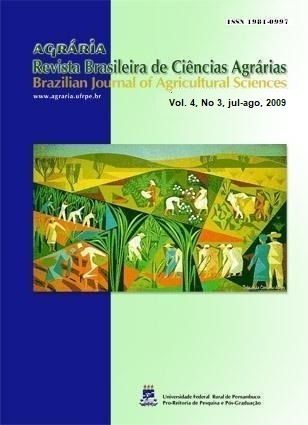Consumo alimentar do camarão marinho <i>Litopenaeus vannamei</i> em sistema fechado com a utilização de probióticos
DOI:
https://doi.org/10.5039/agraria.v4i3a18Palavras-chave:
Bacillus, ração, recirculaçãoResumo
O presente estudo objetivou avaliar o consumo alimentar do camarão marinho Litopenaeus vannamei em sistema de cultivo fechado com aplicação de probióticos. Foram utilizados quatro tratamentos, todos com sistema de recirculação de água: probiótico (Bacillus sp.) adicionado na água e na ração (PWF); apenas na água (PW); apenas na ração (PF); e sem adição de probiótico (NP). Os camarões com peso médio de 3,48 ± 0,62 g foram estocados (200 camarões m-2) em cada uma das doze parcelas experimentais (caixas de 50 L). A ração peletizada foi ofertada em quatro refeições diárias na proporção de 7,5% da biomassa. Durante sete dias consecutivos, as sobras destas refeições foram recolhidas após quatro horas, colocadas em filtros pré-pesados e secas em estufa a uma temperatura de 60 ºC. Os valores de consumo alimentar (g de ração por alimentação) foram inferiores nos tratamentos PWF (0,45
g) e PW (0,32 g), os quais diferiram significativamente quando comparados com os tratamentos PF (0,60 g) e NP (0,59 g). O probiótico contribuiu para a diminuição do consumo alimentar quando o mesmo foi adicionado na água de cultivo, sem comprometer o crescimento de L. vannamei.
Downloads
Downloads
Publicado
Como Citar
Edição
Seção
Licença

Este trabalho está licenciado sob uma licença Creative Commons Attribution 4.0 International License.


